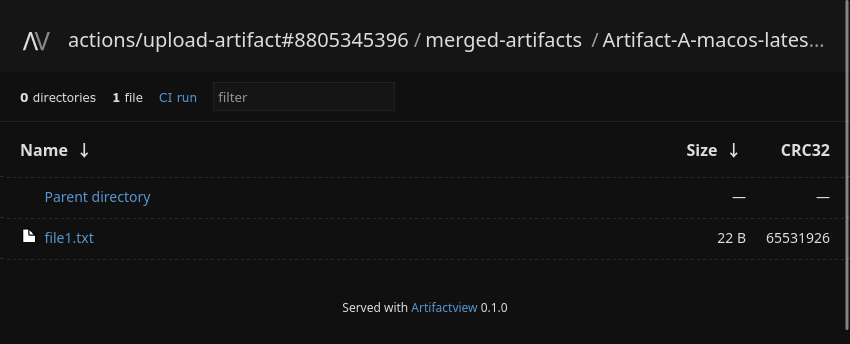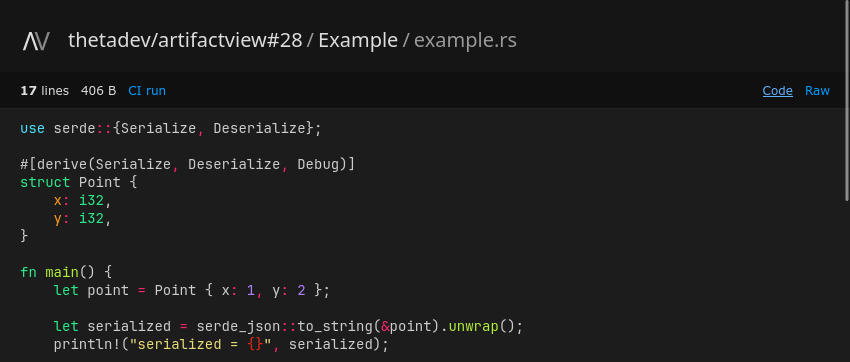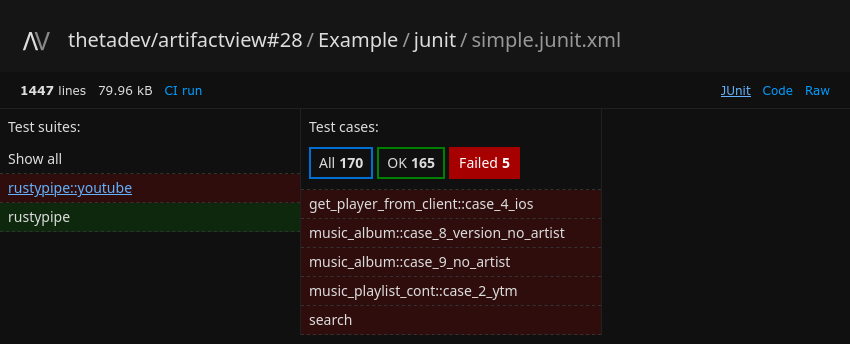| .forgejo/workflows | ||
| crates | ||
| resources | ||
| src | ||
| templates | ||
| tests | ||
| .editorconfig | ||
| .env.example | ||
| .gitignore | ||
| .pre-commit-config.yaml | ||
| build.rs | ||
| Cargo.lock | ||
| Cargo.toml | ||
| CHANGELOG.md | ||
| cliff.toml | ||
| Dockerfile | ||
| Justfile | ||
| LICENSE | ||
| README.md | ||
| renovate.json | ||
Artifactview
This is a test PR: 5
View CI build artifacts from Forgejo/GitHub using your web browser!
Forgejo and GitHub's CI systems allow you to upload files and directories as artifacts. These can be downloaded as zip files. However there is no simple way to view individual files of an artifact.
That's why I developed Artifactview. It is a small web application that fetches these CI artifacts and serves their contents.
It is a valuable tool in open source software development: you can quickly look at test reports or coverage data or showcase your single page web applications to your teammates.
Features
- 📦 Quickly view CI artifacts in your browser without messing with zip files
- 📂 File listing for directories without index page
- 🏠 Every artifact has a unique subdomain to support pages with absolute paths
- 🌎 Full SPA support with
200.htmland404.htmlfallback pages - 👁️ Viewer for Markdown, syntax-highlighted code and JUnit test reports
- 🐵 Greasemonkey userscript to automatically add a "View artifact" button to GitHub/Gitea/Forgejo
- 🦀 Fast and efficient, only extracts files from zip archive if the client does not support gzip
- 🔗 Automatically creates pull request comments with links to all build artifacts
How to use
Open a Github/Gitea/Forgejo actions run with artifacts and paste its URL into the input
box on the main page. You can also pass the run URL with the ?url= parameter.
Artifactview will show you a selection page where you will be able to choose the artifact you want to browse.
If there is no index.html or fallback page present, a file listing will be shown so
you can browse the contents of the artifact.
If you want to use Artifactview to showcase a static website, you can make use of
fallback pages. If a file named 200.html is placed in the root directory, it will be
served in case no file exists for the requested path. This allows serving single-page
applications with custom routing. A custom 404 error page is defined using a file named
404.html in the root directory.
The behavior is the same as with other web hosts like surge.sh, so a lot of website build tools already follow that convention.
Artifactview includes different viewers to better display files of certain types that
browsers cannot handle by default. There is a renderer for markdown files as well as a
syntax highlighter for source code files. The viewers are only shown if the files are
accessed with the ?viewer= URL parameter which is automatically set when opening a
file from a directory listing. You can always download the raw version of the file via
the link in the top right corner.
Artifactview even includes an interactive viewer for JUnit test reports (XML files with
junit in their filename). The application has been designed to be easily extendable,
so if you have suggestions on other viewers that should be added, feel free to create an
issue or a PR.
Accessing Artifactview by copying the CI run URL into its homepage may be a little bit tedious. That's why there are some convenient alternatives available.
You can install the Greasemonkey userscript from the link at the bottom of the homepage. The script adds a "View artifact" link with an eye icon next to every CI artifact on both GitHub and Forgejo.
If you want to give every collaborator to your project easy access to previews, you can automatically create a comment with links to the artifacts under every pull request.
To accomplish that, simply add this step to your CI workflow (after uploading the artifacts).
- name: 🔗 Artifactview PR comment
if: ${{ always() && github.event_name == 'pull_request' }}
run: |
if [[ "$GITEA_ACTIONS" == "true" ]]; then RUN_NUMBER="$GITHUB_RUN_NUMBER"; else RUN_NUMBER="$GITHUB_RUN_ID"; fi
curl -SsL --fail-with-body -w "\n" -X POST https://av.thetadev.de/.well-known/api/prComment -H "Content-Type: application/json" \
--data '{"url": "'"$GITHUB_SERVER_URL/$GITHUB_REPOSITORY/actions/runs/$RUN_NUMBER"'", "pr": ${{ github.event.number }}}'
API
Artifactview does have a HTTP API to access data about the CI artifacts. To make the API
available to every site without interfering with any paths from the artifacts, the
endpoints are located within the reserved /.well-known/api directory.
Get list of artifacts of a CI run
GET /.well-known/api/artifacts?url=<RUN_URL>
GET <HOST>--<USER>--<REPO>--<RUN>-<ARTIFACT>.example.com/.well-known/api/artifacts
Response
Note: the difference between download_url and user_download_url is that the
first one is used by the API client and the second one is shown to the user.
user_download_url is only set for GitHub artifacts. Forgejo does not have different
download URLs since it does not require authentication to download artifacts.
[
{
"id": 1,
"name": "Example",
"size": 1523222,
"expired": false,
"download_url": "https://codeberg.org/thetadev/artifactview/actions/runs/28/artifacts/Example",
"user_download_url": null
}
]
Get metadata of the current artifact
GET <HOST>--<USER>--<REPO>--<RUN>-<ARTIFACT>.example.com/.well-known/api/artifact
Response
{
"id": 1,
"name": "Example",
"size": 1523222,
"expired": false,
"download_url": "https://codeberg.org/thetadev/artifactview/actions/runs/28/artifacts/Example",
"user_download_url": null
}
Get all files from the artifact
GET <HOST>--<USER>--<REPO>--<RUN>-<ARTIFACT>.example.com/.well-known/api/files
Response
[
{ "name": "example.rs", "size": 406, "crc32": "2013120c" },
{ "name": "README.md", "size": 13060, "crc32": "61c692f0" }
]
Create a pull request comment
POST /.well-known/api/prComment
Artifactview can create a comment under a pull request containing links to view the artifacts. This way everyone looking at a project can easily access the artifact previews.
To use this feature, you need to setup an access token with the permission to create comments for every code forge you want to use (more details in the section Access tokens).
To prevent abuse and spamming, this endpoint is rate-limited and Artifactview will only create comments after it verified that the workflow matches the given pull request and the worflow is still running.
| JSON parameter | Description |
|---|---|
url (string) ❕ |
CI workflow URL Example: https://codeberg.org/ThetaDev/artifactview/actions/runs/31 |
pr (int) ❕ |
Pull request number |
recreate (bool) |
If set to true, the pull request comment will be deleted and recreated if it already exists. If set to false or omitted, the comment will be edited instead. |
title (string) |
Comment title (default: "Latest build artifacts") |
artifact_titles (map) |
Set custom titles for your artifacts. Example: {"Hello": "🏠 Hello World ;-)"} |
artifact_paths (map) |
Set custom paths for your artifacts if you want the links to point to a specific file (e.g. a test report). Example: {"Test": "/junit.xml?viewer=1"} |
Response
{ "status": 200, "msg": "created comment #2183634497" }
Setup
You can run artifactview using the docker image provided under
thetadev256/artifactview:latest or bare-metal using the provided binaries.
Artifactview is designed to run behind a reverse proxy since it does not support HTTPS
by itself. If you are using a reverse proxy, you have to set the REAL_IP_HEADER option
to the client IP address header name provided by the proxy (usually x-forwarded-for.
Otherwise artifactview will assume it is being accessed by only 1 client (the proxy
itself) and the rate limiter would count all users as one.
Docker Compose
Here is an example setup with docker-compose, using Traefik as a reverse proxy:
services:
artifactview:
image: thetadev256/artifactview:latest
restart: unless-stopped
networks:
- proxy
environment:
ROOT_DOMAIN: av.thetadev.de
REAL_IP_HEADER: x-forwarded-for
GITHUB_TOKEN: github_pat_123456
REPO_WHITELIST: github.com;codeberg.org;code.thetadev.de
SITE_ALIASES: gh=>github.com;cb=>codeberg.org;th=>code.thetadev.de
labels:
- "traefik.enable=true"
- "traefik.docker.network=proxy"
- "traefik.http.routers.artifactview.entrypoints=websecure"
- "traefik.http.routers.artifactview.rule=HostRegexp(`^[a-z0-9-]*.?av.thetadev.de$`)"
networks:
proxy:
external: true
Configuration
Artifactview is configured using environment variables.
Note that some variables contain lists and maps of values. Lists need to have their
values separated with semicolons. Maps use an arrow => between key and value, with
pairs separated by semicolons.
Example list: foo;bar, example map: foo=>f1;bar=>b1
| Variable | Default | Description |
|---|---|---|
PORT |
3000 | HTTP port |
CACHE_DIR |
/tmp/artifactview | Temporary directory where to store the artifacts |
ROOT_DOMAIN |
localhost:3000 | Public hostname+port number under which artifactview is accessible. If this is configured incorrectly, artifactview will show the error message "host does not end with configured ROOT_DOMAIN" |
RUST_LOG |
info | Logging level |
NO_HTTPS |
false | Set to True if the website is served without HTTPS (used if testing artifactview without an ) |
MAX_ARTIFACT_SIZE |
100000000 (100 MB) | Maximum size of the artifact zip file to be downloaded |
MAX_FILE_SIZE |
100000000 (100 MB) | Maximum contained file size to be served |
MAX_FILE_COUNT |
10000 | Maximum amount of files within a zip file |
MAX_AGE_H |
12 | Maximum age in hours after which cached artifacts are deleted |
ZIP_TIMEOUT_MS |
1000 | Maximum time in milliseconds for reading the index of a zip file. If this takes too long, the zip file is most likely excessively large or malicious (zip bomb) |
GITHUB_TOKEN |
- | GitHub API token for downloading artifacts and creating PR comments. Using a fine-grained token with public read permissions is recommended |
FORGEJO_TOKENS |
- | Forgejo API tokens for creating PR comments Example: codeberg.org=>fc010f65348468d05e570806275528c936ce93a4 |
MEM_CACHE_SIZE |
50 | Artifactview keeps artifact metadata as well as the zip file indexes in memory to improve performance. The amount of cached items is adjustable. |
REAL_IP_HEADER |
- | Get the client IP address from a HTTP request header If Artifactview is exposed to the network directly, this option has to be unset. If you are using a reverse proxy the proxy needs to be configured to send the actual client IP as a request header. For most proxies this header is x-forwarded-for. |
LIMIT_ARTIFACTS_PER_MIN |
5 | Limit the amount of downloaded artifacts per IP address and minute to prevent excessive resource usage. |
LIMIT_PR_COMMENTS_PER_MIN |
5 | Limit the amount of pull request comment requests per IP address and minute to prevent spamming. |
REPO_BLACKLIST |
- | List of sites/users/repos that can NOT be accessed. The blacklist takes precedence over the whitelist (repos included in both lists cannot be accessed) Example: github.com/evil-corp/world-destruction;codeberg.org/blackhat;example.org |
REPO_WHITELIST |
- | List of sites/users/repos that can ONLY be accessed. If the whitelist is empty, it will be ignored and any repository can be accessed. Uses the same syntax as REPO_BLACKLIST. |
SITE_ALIASES |
- | Aliases for sites to make URLs shorter Example: gh => github.com;cb => codeberg.org |
SUGGESTED_SITES |
codeberg.org; github.com; gitea.com | List of suggested code forges (host only, without https://, separated by ;). If repo_whitelist is empty, this value is used for the matched sites in the userscript. The first value is used in the placeholder URL on the home page. |
VIEWER_MAX_SIZE |
500000 | Maximum file size to be displayed using the viewer |
Access tokens
GitHub does not allow downloading artifacts for public repositories for unauthenticated users. So you need to setup an access token to use Artifactview with GitHub.
If you are not using the prComment feature, you can use a fine-grained access token
with the "Public repositories (read-only)" permission. If you want to create pull
request comments, you have to use a classic token with the "public_repo" scope enabled
(the fine-grained tokens did not work in my test).
Forgejo does not require access tokens to download artifacts on public repositories, so
you only need to create a token if you want to use the prComment-API. In this case,
the token needs the following permissions:
- Repository and Organization Access: Public only
- issue: Read and write
- user: Read (for determining own user ID)
Note that if you are using Artifactview to create pull request comments, it is recommended to create a second bot account instead of using your main account.
Technical details
URL format
Artifactview uses URLs in the given format for accessing the individual artifacts:
<HOST>--<USER>--<REPO>--<RUN>-<ARTIFACT>.hostname
Example: https://github-com--theta-dev--example-project--4-11.example.com
The reason for using subdomains instead of URL paths is that many websites expect to be
served from a separate subdomain and access resources using absolute paths. Using URLs
like example.com/github.com/theta-dev/example-project/4/11/path/to/file would make the
application easier to host, but it would not be possible to preview a React/Vue/Svelte
web project.
Since domains only allow letters, numbers and dashes but repository names allow dots and underscores, these escape sequences are used to access repositories with special characters in their names.
-0->.-1->--2->_
Another issue with using subdomains is that they are limited to a maximum of 63 characters. Most user and repository names are short enough for this not to become a problem, but it could still happen that a CI run becomes inaccessible. Since the run ID is incremented on each new CI run, it might even happen that Artifactview works fine at the beginning of a project, but the subdomains exceed the length limit in the future.
That's why I added aliases for forge URLs. You can for example alias github.com as gh, shaving 8 characters from the subdomain. This makes the subdomains short enogh that you will be unlikely to hit the limit even with longer user/project names.
Security considerations
It is recommended to use the whitelist feature to allow artifactview to access only trusted servers, users and organizations.
Since many
well-known URIs
are used to configure security-relevant properties of a website or attest ownership of a
website (like .well-known/acme-challenge for issuing TLS certificates), Artifactview
will serve no files from the .well-known folder.
There is a configurable limit for both the maximum downloaded artifact size and the maximum size of individual files to be served (100 MB by default). Additionally there is a configurable timeout for the zip file indexing operation. These measures should protect the server against denial-of-service attacks like overfilling the server drive or uploading zip bombs.



